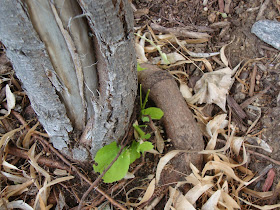By Carol O’Meara, CSU Extension Horticulture Entomologist, Boulder County
When insects sing their summer songs, love rises to a crescendo in the garden. Valentines day can’t hold a candle to the trills, chirps, clicks and drums that form a symphony of sound in the height of heat. Who are these plaintive lovers singing for romance? Bend an ear to the different calls and you’ll find love comes on many splendored wings.
Horn section
Dog Day Cicadas (Tibicen spp.) are well known for the band-saw-like serenades of males advertising their appeal. Resting on branches, occasionally sucking sap from twigs, the males call by vibrating a membrane, called a tymbal, in their abdomens.
The females pass judgment on male suitability by the quality of their song, but how they can distinguish one male’s notes from another is baffling when they sing in unison. Buzzing in concert with each other, male cicada song can be very loud, occasionally rising to shrieking pitch before quieting down.
Cicadas are often confused with locusts, but have a squat body with wide-set eyes and large, clear wings. You’ll find them gathered on trunks and tree branches late in summer.
Strings
Some insects use their wings in a modified version of a violin, holding one wing aloft while drawing the other over it. The wing acts as an amplifier, channeling sound into the night air to woo females close. Snowy tree crickets (Oecanthus fultoni) are one of the most beloved night singers in the region.
Thanks to Hollywood movies using their song as the epitome of night sound, these rarely seen crooners hang out in trees, shrubbery and vines. Chirping in concert with the heat, their song becomes faster as temperatures rise. Clinging to the undersides of leaf or branch, snowy tree crickets blend into surrounding vegetation and are difficult to spot. Look for pale green crickets with long antennae whenever you hear their call.
Listen to it at the Singing Insects of North America site, buzz.ifas.ufl.edu/585a.htm.
True Katydids (Pterophylla camellifolia) are newcomers to the Front Range music scene, bringing with them a unique file-on-metal sound females find irresistible. These raspy voiced Romeos are laid back musicians, slow moving and loath to fly, and can be found in the tops of deciduous trees. Singing solo, their song is often slow and easy, but in chorus the tempo is more upbeat with nearby males playing off one another to form a quick tune.
To find them, look for tall, narrow, green insects resembling a leaf.
Percussion
Many arthropods use drumbeats from foot or abdomen to pound the earth and gain attention, including wolf spiders, Mormon crickets, or grasshoppers. Their repertoire isn’t limited to simple beats; some use a combination of taps and rubs that keep up a percussive rhythm. The garden should be very quiet to hear this sound and many in urban or suburban yards will miss it altogether due to background noise.
Divas
No concert is complete without a diva, and female Culex tarsalis mosquitoes are headliners of sound. When Culex enters the summer stage, she sets off a whine no male can ignore. Using her wings to belt out a song, the female draws crowds of hopeful suitors to her side, where they form a cloud-like entourage to follow her about.
Like most prima donnas, gardeners would be better off without the antics of female mosquitoes, but they are a staple of summer evenings and serve a purpose in the larger food chain. If you choose to search for summer songsters, take precautions against being bitten by wearing long sleeves and slacks while out after dusk, and use repellants if they don’t cause you allergic reactions.



















































